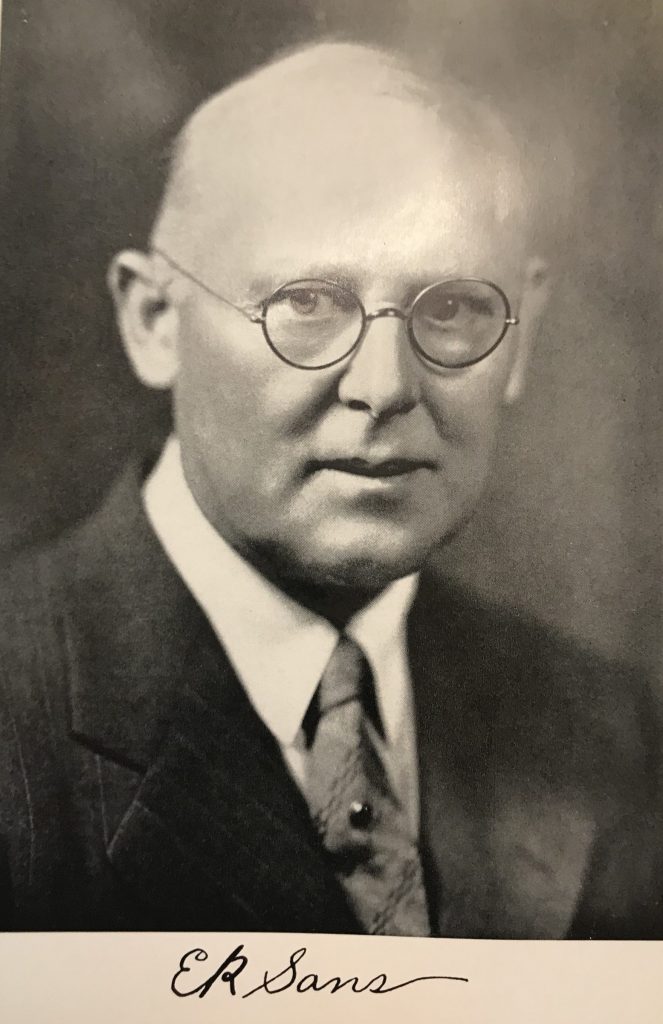EDWARD R. SANS is a Pacific Coast man, has been a farmer, rancher, lumber man, explorer, and during his early years developed a keen and practical knowledge of natural science. For many years he has been familiarly referred to as “the coyote man” of Nevada, working under the United States Biological Survey, with specific duties in charge of the predatory animal and rodent control in the state. He was born at Soledad, Monterey County, California, April 23, 1875, son of Charles and Sarah E. (Ray) Sans. His father was a native of Indiana, and when very young his family moved to Quincy, Illinois. When he was fourteen years of age, in 1852, he started across the plains to California in company with his older brothers and sisters. The party endured numerous hardships as they encountered the physical obstacles of such a trip, but a still worse scourge was the cholera epidemic then raging, to which one of his sisters and two of his brothers fell victims. Charles Sans was the last surviving member of his generation and was eighty six years of age when he died in San Benito County. He was a stock man in Monterey County, but sold out his interests in 1884 and bought a fruit ranch in Santa Cruz County. After selling that he moved to Mayfield near Palo Alto, and after his wife died there, he went to San Benito County and lived with his son Frank W. until his death. His wife, Sarah E. Ray, crossed the plains during the ’60s with her parents, there being fourteen wagons in the train. Her people first stopped in the Sacramento Valley near Ione and from there went to Monterey County. She died at the age of fifty-six. She was the mother of four sons and two daughters, all living but one daughter. Edward R. is the only member of the family in Nevada, the others living in California and Oregon. The sister Alice is the wife of Finda Coppock, of Oregon. Charles is a farmer in Santa Cruz County and A.W. is city attorney of Watsonville, California. Frank W. Sans, a farmer at Hollister, California, was a private in the World war, enlisting as a volunteer. After training at Camp Lewis, he was one of the first sent overseas. He was a gunner in the Trench Mortar Battalion, and for months lived in the mud until he contracted rheumatism and had to be sent to a hospital. While recuperating the French discovered that he was an expert farmer and employed him to demonstrate American methods of wheat growing. His last work was in getting supplies to the front. He is now a successful farmer. When America entered the war, he had 600 acres of wheat ripening for harvest, and he walked away from it, telling his brothers to take care of it. The deceased daughter was Myrtle, wife of Louie Domeyer. She died at the age of twenty-three at Mayfield.
Edward R. Sans attended public school in Green Valley near Watsonville and then for eight years worked for a nurseryman and orchardist at Corralitos. During the last four years he was superintendent, though the youngest man on the ranch. He then joined his brother Charles in the sawmill business in the Coast Range Mountains. The Sans brothers operated a commercial mill at the little town west of Jolon, sawing up redwood lumber. He continued in that business for nearly fifteen years, and the brothers also owned a ranch of 600 acres, adjoining the property of William Randolph Hearst. This ranch was subsequently sold to Mr. Hearst and now constitutes part of the great Hearst estate.

As a result of impaired health, making it necessary that he should live outdoors, Mr. Sans in 1912 accepted the opportunity to go with the Biological Survey. He first took charge of a group of university students handling rodent extermination in the national forests. In 1913 he was sent to Gerlach, Nevada, to make a report on the need for exterminating coyotes, which were then ravaging the herds. His first report was that the coyotes were not doing any material damage, but during the lambing season he changed his mind, after witnessing the heavy slaughter made by these predatory animals. In 1915 Mr. Sans was assigned duty in Oregon to help control an outbreak of rabies, and he organized the systematic hunting and extermination of wild animals there.
In the fall of 1915 he returned to Nevada, to take up the work of predatory animal control for the districts of both Nevada and California. With headquarters at Winnemucca he undertook an organized campaign against coyotes, bobcats and mountain lions.
In 1912 an epidemic of rabies had broken out in the western states. Investigation showed that the origin of the plague was an infected dog which had been brought to Los Angeles by a circus. During three years thirty-six persons died from rabies in California. The disease had been communicated among coyotes and other wild animals of the plains and it was for the purpose of preventing the further spread of the disease that the Biological Survey assigned Mr. Sans to this work in cooperation with local authorities. While he was at Winnemucca, he received a letter addressed “to the coyote man.” He was, himself, new in the community, but his mission was thoroughly well known, and the post office authorities had no hesitation in dropping the letter at his door. In 1920, the work assigned him being too heavy for one man to handle, the district was divided and since then his supervision has been limited to Nevada. Since the control work started in Nevada in 1915, he estimates that the systematic extermination has killed nearly 100,000 coyotes, wildcats and mountain lions. His work is under the civil service regulations of the Department of Agriculture. His office is in the Gazette Building at Reno.
Mr. Sans is a Republican, though in state and county affairs he votes independently. While in California he was a member of the State Central Committee for Monterey County, and for several years was deputy county assessor there. In Reno he was for two years president of the Federal Business Association and is president of the Federal Employees Union at Reno.
Photographs on the walls of his office at Reno indicate that Mr. Sans was at one time an ardent duck shooter. However, since making a profession of the killing of wild animals, the “lust to kill” has been considerably modified and he much prefers to shoot with a camera. Perhaps his chief hobby has been a constructive interest in developing the herds of antelope in Nevada. Some years ago, observing the flight of these splendid wild game animals, he succeeded in effecting a closed hunting season and in setting aside a refuge in Northern Washoe County, containing 28,000 acres, where now there are several thousand antelopes roaming at will and protected by the law to a full extent.
February 15, 1894, Mr. Sans married Lydia M. Rich, of Corralitos, California. Of the six children of this marriage, Carl E. was accidentally killed during the deer hunting season in 1925. All were born in California and the living children are all married except the youngest. Mabel is Mrs. E. A. Plaskett, of King City, California; Olive is Mrs. Lawson M. Plaskett, of Lockwood, California, these daughters marrying brothers. Albert lives at Lockwood, Elsie is Mrs. Ralph Floyd, of Long Beach, and Charles is in high school at Wineville, California. At Reno, April 29, 1917, Mr. Sans married Pearl E. Gibson, of Winnemucca. She was born in Minnesota, reared and educated in that state, and for the sake of her health went to Idaho and then to Winnemucca, where she became chief operator for the Bell Telephone Company.
Mabel Sans Plaskett was born in Coralitas near Ben Lomond in the Santa Cruz Mountain area of California. Her father Edward Robert Sans ran a saw mill near Pacific Valley, along the Nacimiento - Ferguson road to the coast at Highway One. It was there she met Edward Abbott Plaskett, her husband. Mabel wrote about the coast and the pioneers of the 19th and 20th Centuries.

Recent Comments